Imagine stepping into your backyard and sinking into the warm, bubbling embrace of a spa, followed by a refreshing swim in your crystal-clear pool. Combining a swimming pool with a spa is the ultimate way to enhance your home’s value, aesthetics, and lifestyle. At Hi Poolss, we specialize in designing and building custom pools with integrated spas that cater to your unique needs. In this comprehensive guide, we’ll explore everything from maintenance and costs to design tips and health benefits, ensuring your dream outdoor retreat becomes a reality.
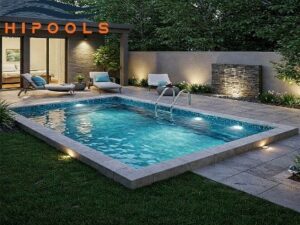
Maintenance Tips for Pools with Spas
Proper maintenance ensures your pool and spa remain safe, clean, and functional year-round.
1. Balance Water Chemistry
– Test water weekly for pH (7.2–7.8), alkalinity (80–120 ppm), and sanitizer levels.
– Spas require extra attention due to higher temperatures, which accelerate chemical evaporation.
2. Clean Filters and Surfaces
– Backwash sand filters monthly.
– Skim debris daily and vacuum floors weekly to prevent clogs.
– Drain and clean spa jets every 3–4 months to remove bacteria buildup.
3. Inspect Equipment
– Check pumps, heaters, and valves for leaks or unusual noises.
– Lubricate O-rings and seals to prolong equipment life.
4. Seasonal Adjustments
– Winterize pipes in colder climates to prevent freezing.
– Use thermal covers for spas to retain heat efficiently.
5. Professional Servicing
Hi Poolss offers maintenance packages to handle complex tasks like acid washing or motor repairs.
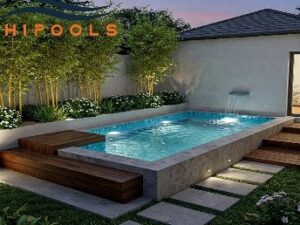
Cost Considerations for Installing a Pool with a Spa
Understanding costs helps you budget wisely for your project.
Initial Costs
– Design and Materials: Fiberglass ($45k–$80k) vs. Concrete ($60k–$120k).
– Labor: Excavation, plumbing, and electrical work ($20k–$40k).
– Permits: Local regulations may add $500–$2,000.
Long-Term Expenses
– Energy: Heat pumps for spas cost $500–$1,200 annually.
– Maintenance: Monthly chemicals and cleaning average $100–$300.
Savings Tips
– Opt for energy-efficient variable-speed pumps.
– Bundle pool and spa installations to reduce labor costs.
How to Choose the Right Location for Your Pool and Spa
Selecting the ideal location for your pool and spa requires a thoughtful balance of practicality, aesthetics, and long-term functionality. Begin by analyzing sunlight and wind patterns as these elements significantly impact comfort and operational costs. Position spas in areas that receive ample sunlight throughout the day, ideally facing south or west in cooler climates to maximize natural warmth and extend the swimming season. For pools, consider how seasonal sun angles affect shade—avoid placing them under trees or structures that cast shadows during peak swimming hours. At the same time, shield the pool area from prevailing winds using barriers like hedges, privacy walls, or pergolas. Windbreaks not only reduce evaporation and heat loss but also create a calmer environment for swimmers. In coastal or windy regions, materials like tempered glass or lattice screens can blend functionality with design while minimizing maintenance.
Privacy and accessibility are equally critical. Spas, often used year-round, should be situated near high-traffic areas like patios, outdoor kitchens, or master suites for convenience. However, balance accessibility with seclusion by integrating natural elements such as climbing vines, bamboo clusters, or tiered planters that soften hardscapes and block sightlines. For pools, ensure the surrounding space accommodates lounging areas, safety equipment, and pathways that comply with local building codes. Wider decks with non-slip surfaces enhance safety, while strategic lighting along walkways improves nighttime usability. If space allows, create distinct zones—such as a shaded cabana or sunbathing ledge—to cater to different activities and user preferences.
Before breaking ground, address utility lines and drainage to avoid costly delays or hazards. Collaborate with utility companies to map underground gas, electrical, or water lines, and adjust your design to maintain safe clearance. Additionally, evaluate soil composition and grading: sloped sites may require retaining walls or terracing to prevent erosion, while clay-heavy soils might need additional drainage solutions like French drains or permeable pavers. Ensure the pool’s elevation directs rainwater away from the structure and neighboring properties to prevent flooding. In regions with heavy rainfall, incorporate overflow channels or scuppers into the design.
Finally, consider long-term maintenance and local regulations. Check zoning laws for setback requirements, fencing height restrictions, or noise ordinances that could influence placement. For example, some municipalities mandate a minimum distance between pools and property lines or require self-locking gates for safety. Aesthetic harmony is also key—align the pool’s shape and materials with your home’s architecture and landscape style. Neutral tones and natural stone, for instance, can create a timeless look, while geometric designs with bold tiles might complement modern homes. By addressing these factors holistically, you’ll create a durable, inviting retreat that enhances your property’s value and enjoyment for years to come.
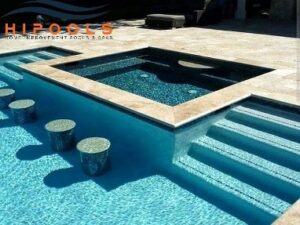
Safety Features for Swimming Pools with Spas
Safety is non-negotiable for families and compliance.
1. Barriers and Alarms
- Install 4-foot fences with self-latching gates.
- Use motion sensors or surface wave alarms.
2. Anti-Entrapment Covers
- Choose compliant drain covers to prevent accidents.
3. Slip-Resistant Surfaces
- Opt for textured finishes like exposed aggregate or brushed concrete.
4. Emergency Equipment
- Keep life rings and first-aid kits nearby.
Popular Materials for Pool and Spa Construction
Concrete: Durable and customizable but requires frequent resurfacing.
Fiberglass: Low maintenance, quick installation, but limited shapes.
Vinyl Liners : Budget-friendly but prone to punctures.
Aesthetic Touches
– Glass tiles for shimmering water effects.
– Natural stone coping for a rustic look.
Landscaping Ideas Around Pools and Spas
Creating a tropical oasis around your pool or spa brings a vacation-like vibe to your backyard. Incorporate palm trees, vibrant bird-of-paradise plants, and bamboo screens for privacy and lush greenery. These elements evoke a serene, resort-inspired atmosphere, while water-friendly plants thrive in the humid microclimate near the pool.
For a sleek, contemporary look, opt for modern minimalism. Use geometric stone or concrete pavers for clean lines, paired with monochromatic planters filled with sculptural succulents or ornamental grasses. Add a streamlined fire pit or a reflective water feature to enhance the sophisticated, uncluttered aesthetic.
Extend your living space by integrating functional outdoor areas. Install a pergola draped with climbing vines for shade, built-in seating with weather-resistant cushions, or an outdoor kitchen for entertaining. These features blend comfort and practicality, turning the poolside into a hub for gatherings.
Lighting plays a key role in ambiance and safety. Submersible LED pool lights cast a soft glow on the water, while solar-powered pathway lanterns guide movement after dark. Strategically placed uplighting can also highlight architectural plants or design elements, ensuring the space remains inviting day and night.
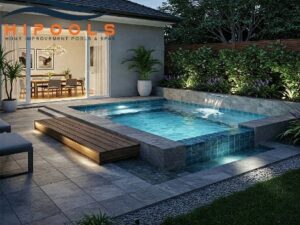
The Health Benefits of Swimming Pools and Spas
– Low-Impact Exercise: Ideal for arthritis or injury recovery.
– Stress Relief: Hydrotherapy jets ease muscle tension.
– Improved Sleep: Warm spa soaks before bed promote relaxation.
A Guide to Pool Care and Maintenance
swimming pool maintenance for beginners
Ready to start?
A pool with a spa transforms your backyard into a sanctuary of wellness and entertainment. At Hi Poolss, we’re committed to delivering tailored solutions that exceed expectations. Ready to dive in? Contact us today for a free consultation!

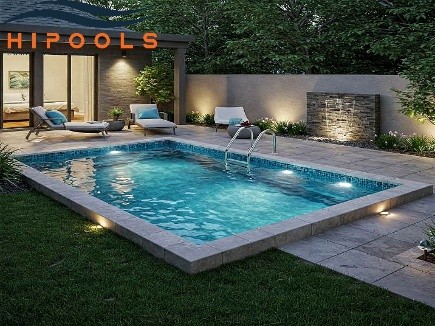
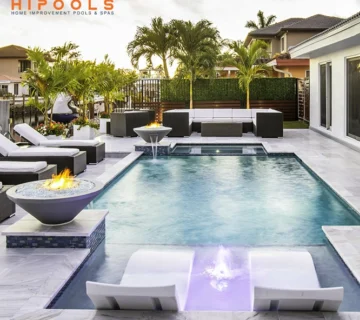
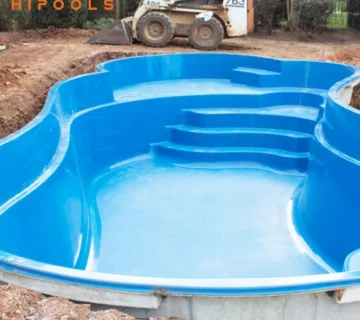
No comment